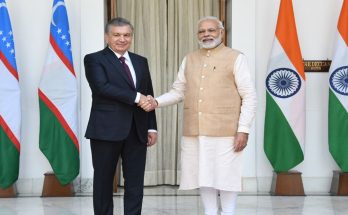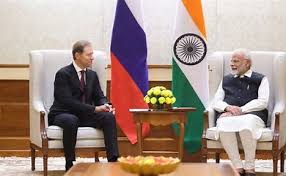 India’s GDP data has been revised recently and the new figures tell a different story — of robust growth rather than of policy paralysis and industrial decline in 2013-14. According to the revised Gross Domestic Value added, Indian economy grew at 6.9 per cent in 2013-14 and not at 4.5 per cent. Strangely, it was on the back of a slow economy that the NDA government came to power! People voted for the revival of the economy which was growing at below 5 per cent.
India’s GDP data has been revised recently and the new figures tell a different story — of robust growth rather than of policy paralysis and industrial decline in 2013-14. According to the revised Gross Domestic Value added, Indian economy grew at 6.9 per cent in 2013-14 and not at 4.5 per cent. Strangely, it was on the back of a slow economy that the NDA government came to power! People voted for the revival of the economy which was growing at below 5 per cent.
In arriving at the new GDP growth figures, the base for calculating GDP figures has been changed to 2011-12 from 2004-2005. But strangely even with a much higher rate of growth, the size of the economy remains more or less the same at $1.8 trillion for 2013-14. Both manufacturing growth and agricultural growth however have been estimated higher than previously. But real capital formation grew only at 3 per cent. Manufacturing and mining sectors, according to the new series, grew at 5.3 percent at 5.4 per cent, instead of showing negative growth.
The revised GDP has been calculated on the basis of the gross value of production at market prices of goods and services that include indirect taxes, instead of being calculated by factory costs. Various underrepresented sectors have been included like the informal sector.
Manufacturing sector’s contribution to the GDP is now 18 per cent for 2013-14 instead of 15 per cent while the share of real estate, hotels, financial and business services are now contributing a smaller share of GDP at 51 per cent instead of 60 per cent. Agriculture’s contribution has also increased to 17 per cent from earlier 14 per cent.
Many people have cast doubts on the revised data showing high growth performance comparable to China’s. Even Chief Economic Advisor Arvind Subramanian has been puzzled. Because other indicators do not seem to corroborate the high rate of growth especially when imports actually declined last year and there was outflow of capital during this period. Why should imports decline when the economy is doing so well? Company profits also did not reflect the high growth in 2013-14. Moreover, private investment and credit offtake remained slack and there were mounting bad assets with banks. Car sales, a good indicator of industrial growth, also remained lackluster. More evidence is therefore needed to make the new figures more convincing.
The new numbers will be important for policy because now India is projected to grow at 7.4 per cent during the year ending March 2015. Prime Minister Modi has been trying to improve the business environment and wants to escalate manufacturing growth through his “make in India” campaign. His election victory rested on his wanting to raise manufacturing growth in order to provide jobs to the youth.
How does the common person feel about the new higher per capita income which accompanies the new higher rate of growth? Most people would be puzzled by the new data because even though the petrol prices have come down and inflation is really low, they are not feeling well off. This is because it takes many other things to make a real difference to one’s life. Unless there is more equitable growth, with better social services, less commuting hassles, less pollution, access to clean water and stable jobs, the ‘feel good’ factor will be low.
Most people also rightly feel that only the rich are getting richer. The recent World Bank report on Inequality in South Asia shows that in India the rich are getting richer and India’s high growth is favouring them. Based on the 59th Round of National Statistical Sample Organization (NSSO) that focused on measuring wealth ( land, financial assets, buildings etc.), the average net worth of the top 10 per cent of the population was 380 times that of the bottom 10 per cent. The net worth of the rich could support their household consumption for 23 years while for the bottom rung, it would support for less than three months.
The rate of increase in the number of billionaires has been the fastest in India as compared to other Asian countries. The report says that the total billionaire wealth represented about 12 per cent of the GDP in 2012. In addition 40 per cent of the billionaire wealth is estimated to be due to inheritance while 60 per cent originates from ‘rent thick’ sectors like real estate, infrastructure, construction, mining and telecommunications.
The huge income differences between the richest and the poorest in India means that there is a stark difference in the quality of life of the average individual and health of children. It leads to different capabilities among the people. Children from rich families will always have an advantage over those from poor families though there have been striking exceptions in recent times. The report, however, says that there exists considerable occupational mobility across generations in India. About 40 per cent of those born to unskilled parents are engaged in other occupations. Urbanization enhances mobility and provides greater opportunities for migration and change in occupation .
Social mobility has occurred between 2005 and 2010. About 40 per cent of the households moved above the poverty line. Similarly about 11 per cent of the poor and vulnerable moved into the middle class during the same period but about 14 per cent of the non-poor groups slipped back into poverty. Taking into account the high cost of private medical care, it is likely that one major illness in the family led the families to recede into poverty. Thus lack of access to good quality healthcare is making the poor more vulnerable.
The World Bank has moreover stated that South Asia’s ( including India) way of calculating the inequality index denoted by the Gini coefficient is based on consumption per capita comprising of a basket of goods and not income per capita. It does not show the nature of consumption of the rich.
If India is all set to grow at 8 percent growth, lessening of inequality through higher public spending on social and infrastructural reforms would alone bring greater satisfaction to the common person.
(The writer is a Senior Fellow at Observer Research Foundation, Delhi)
Courtesy:ORF
Author Profile
- India Writes Network (www.indiawrites.org) is an emerging think tank and a media-publishing company focused on international affairs & the India Story. Centre for Global India Insights is the research arm of India Writes Network. To subscribe to India and the World, write to editor@indiawrites.org. A venture of TGII Media Private Limited, a leading media, publishing and consultancy company, IWN has carved a niche for balanced and exhaustive reporting and analysis of international affairs. Eminent personalities, politicians, diplomats, authors, strategy gurus and news-makers have contributed to India Writes Network, as also “India and the World,” a magazine focused on global affairs.
Latest entries
 DiplomacyOctober 4, 2025UNGA Resolution 2758 Must Not Be Distorted, One-China Principle Brooks No Challenge
DiplomacyOctober 4, 2025UNGA Resolution 2758 Must Not Be Distorted, One-China Principle Brooks No Challenge India and the WorldJuly 26, 2025MPs, diplomats laud Operation Sindoor, call for national unity to combat Pakistan-sponsored terror
India and the WorldJuly 26, 2025MPs, diplomats laud Operation Sindoor, call for national unity to combat Pakistan-sponsored terror India and the WorldJuly 25, 2025When Fire Ends, Diplomacy Begins
India and the WorldJuly 25, 2025When Fire Ends, Diplomacy Begins India and the WorldJuly 16, 2025Operation Sindoor and its Aftermath: India’s Successful Diplomatic Outreach
India and the WorldJuly 16, 2025Operation Sindoor and its Aftermath: India’s Successful Diplomatic Outreach







